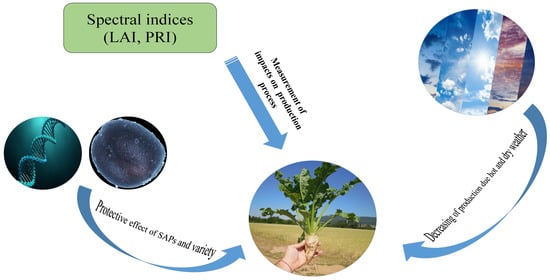Impact of Superabsorbent Polymers and Variety on Yield, Quality and Physiological Parameters of the Sugar Beet (Beta vulgaris prov. Altissima Doell)
Abstract
1. Introduction
2. Results
2.1. Leaf Area Index (LAI)
2.2. Photochemical Reflectance Index (PRI)
2.3. Evaluation of Production Parameters
2.4. Relationships between Physiological and Production Parameters
3. Discussion
4. Materials and Methods
4.1. Characteristics of Location and Soil Conditions
4.2. Variety and Superabsorbent Characteristics
4.3. Experimental Design
4.4. Leaf Area Index Measurement
4.5. Photochemical Reflectance Index Measurement
4.6. Crop Harvest and Quality Analysis of the Sugar Beet
4.7. Statistical Evaluation
5. Conclusions
Author Contributions
Funding
Data Availability Statement
Conflicts of Interest
References
- Bahaa, E.S.; El-Fatah, A.; Hashem, M.; Abo-Elyousr, K.A.M.; Bagy, H.M.M.K.; Alamri, S.A.M. Genetic and biochemical variations among sugar beet cultivars resistant to Cercospora leaf spot. Physiol. Mol. Plant Pathol. 2020, 109, 101455. [Google Scholar] [CrossRef]
- Tzilivakis, J.; Jaggard, K.; Lewis, K.A.; May, M.; Warner, D.J. Environmental impact and economic assessment for UK sugar beet production systems. Agric. Ecosyst. Environ. 2005, 107, 341–358. [Google Scholar] [CrossRef]
- Mohammadi-Ahmadmahmoudi, E.; Deihimfard, R.; Noori, O. Yield gap analysis simulated for sugar beet-growing areas in water-limited environments. Eur. J. Agron. 2020, 113, 125988. [Google Scholar] [CrossRef]
- Wang, M.; Xu, Y.; Wang, W.; Wu, Z.; Xing, W.; Zhang, H. Quantitative trait locus (QTL) mapping of sugar yield-related traits in sugar beet (Beta vulgaris L.). Sugar Tech. 2019, 21, 135–144. [Google Scholar] [CrossRef]
- Kuśmierek-Tomaszewska, R.; Źarski, J.; Dudek, S. Assessment of irrigation needs in sugar beet (Beta vulgaris L.) in temperate climate of Kujawsko-Pomorskie region (Poland). Agronomy 2019, 9, 814. [Google Scholar] [CrossRef]
- Liu, L.; Wang, Y.; Gai, Z.; Liu, D.; Wu, P.; Wang, B.; Zou, C.; Li, C.; Yang, F. Responses of soil microorganisms and enzymatic activities to alkaline stress in sugar beet rhizosphere. Pol. J. Environ. Stud. 2020, 29, 739–748. [Google Scholar] [CrossRef]
- FAOSTAT. Food and Agriculture Organization of the United Nations Website. Available online: www.fao.org/faostat/en/#data/QC (accessed on 26 May 2020).
- Sánchez-Sastre, L.F.; Martín-Ramos, P.; Navas-Gracia, L.M.; Hernández-Navarro, S.; Martín-Gil, J. Impact of climatic variables on carbon content in sugar beet root. Agronomy 2018, 8, 147. [Google Scholar] [CrossRef]
- Cao, Y.; Li, G.L.; Luo, Y.K.; Pan, Q.; Zhang, S.Y. Monitoring of sugar beet growth indicators using wide-dynamic-range vegetation index (WDRVI) derived from UAV multispectral images. Comput. Electron. Agric. 2020, 171, 105331. [Google Scholar] [CrossRef]
- Hoffmann, C.M. Importance of canopy closure and dry matter partitioning for yield formation of sugar beet varieties. Field Crop Res. 2019, 236, 75–84. [Google Scholar] [CrossRef]
- Gamon, J.A.; Peñuelas, J.; Fiekl, C.B. A narrow-waveband spectral index that tracks diurnal changes in photosynthetic efficiency. Remote Sens. Environ. 1992, 41, 35–44. [Google Scholar] [CrossRef]
- Sarlikioti, V.; Driever, S.M.; Marcelis, L.F.M. Photochemical reflectance index as a mean of monitoring early water stress. Ann. Appl. Biol. 2010, 157, 81–89. [Google Scholar] [CrossRef]
- Alonso, L.; Van Wittenberghe, S.; Amorós-López, J.; Vila-Francés, J.; Gómez-Chova, L.; Moreno, J. diurnal cycle relationships between passive fluorescence, PRI and NPQ of vegetation in a controlled stress experiment. Remote Sens. 2017, 9, 770. [Google Scholar] [CrossRef]
- Gamon, J.A. Reviews and syntheses: Optical sampling of the flux tower footprint. Biogeosciences 2015, 12, 4509–4523. [Google Scholar] [CrossRef]
- Wu, C.; Niu, Z.; Tang, Q.; Huang, W. Revised photochemical reflectance index (PRI) for predicting light use efficiency of wheat in a growth cycle: Validation and comparison. Int. J. Remote Sens. 2010, 31, 2911–2924. [Google Scholar] [CrossRef]
- Cheng, Y.-B.; Middleton, E.M.; Zhang, Q.; Huemmrich, K.F.; Campbell, P.K.E.; Corp, L.A.; Cook, B.D.; Kustas, W.P.; Daughtry, C.S. Integrating solar induced fluorescence and the photochemical reflectance index for estimating gross primary production in a cornfield. Remote Sens. 2013, 5, 6857–6879. [Google Scholar] [CrossRef]
- Hoffmann, C.M.; Kenter, C. Yield potential of sugar beet—Have we hit the ceiling? Front. Plant Sci. 2018, 9, 289. [Google Scholar] [CrossRef] [PubMed]
- Curcic, Z.; Ciric, M.; Nagl, N.; Taski-Ajdukovic, K. Effect of sugar beet genotype, planting and harvesting dates and their interaction on sugar yield. Front. Plant Sci. 2018, 9, 1041. [Google Scholar] [CrossRef]
- Hosseini, S.A.; Réthoré, E.; Pluchon, S.; Ali, N.; Billiot, B.; Yvin, J.-C. Calcium application enhances drought stress tolerance in sugar beet and promotes plant biomass and beetroot sucrose concentration. Int. J. Mol. Sci. 2019, 20, 3777. [Google Scholar] [CrossRef] [PubMed]
- Moosavi, S.G.R.; Ramazani, S.H.R.; Hemayati, S.S.; Gholizade, H. Effect of drought stress on root yield and some morpho-physiological traits in different genotypes of sugar beet (Beta Vulgaris L.). J. Crop Sci. Biotechnol. 2017, 20, 167–174. [Google Scholar] [CrossRef]
- Gornall, J.; Betts, R.; Burke, E.; Clark, R.; Camp, J.; Willett, K.; Wiltshire, A. Implications of climate change for agricultural productivity in the early twenty-first century. Philos. Trans. R. Soc. B 2010, 365, 2973–2989. [Google Scholar] [CrossRef] [PubMed]
- Hajheidari, M.; Abdollahian-Noghabi, M.; Askari, H.; Heidari, M.; Sadeghian, S.Y.; Ober, E.S.; Salekdeh, G.H. Proteome analysis of sugar beet leaves under drought stress. Proteomics 2005, 5, 950–960. [Google Scholar] [CrossRef]
- Milford, G.F.J.; Pocock, T.O.; Riley, J. An analysis of leaf growth in sugar beet. Ann. Appl. Biol. 1985, 106, 173–185. [Google Scholar] [CrossRef]
- Hoffmann, C.M. Sucrose accumulation in sugar beet under drought stress. J. Agron. Crop Sci. 2010, 196, 243–252. [Google Scholar] [CrossRef]
- Borišev, M.; Borišev, I.; Župunski, M.; Arsenov, D.; Pajević, S.; Ćurčić, Ž.; Vasin, J.; Djordjevic, A. Drought impact is alleviated in sugar beets (Beta vulgaris L.) by foliar application of fullerenol nanoparticles. PLoS ONE 2016, 11, e0166248. [Google Scholar] [CrossRef]
- Prośba-Bialczyk, U.; Sacala, E.; Wilkosz, M.; Cieciura, M. Impact of seed stimulation and foliar fertilization with microelements on changes in the chemical composition and productivity of sugar beet. J. Elem. 2017, 22, 1525–1535. [Google Scholar] [CrossRef]
- Ashraf, M.; Foolad, M.R. Pre-Sowing Seed Treatment—A shotgun approach to improve germination, plant growth, and crop yield under saline and non-saline conditions. Adv. Agron. 2005, 88, 223–271. [Google Scholar] [CrossRef]
- De Barros, A.F.; Pimentel, L.D.; Araujo, E.F.; De Macedo, L.R.; Martinez, H.E.P.; Batista, V.A.P.; Da Paixão, M.Q. Super absorbent polymer application in seeds and planting furrow: It will be a new opportunity for rainfed agriculture. Semin. Cienc. Agrar. 2017, 38, 1703. [Google Scholar] [CrossRef]
- Darini, A.K.; Naderi, R.; Khalighi, A.; Taheri, M. Effect of superabsorbent polymer on lawn under drought stress condition. Agric. Sci. Dev. 2015, 4, 22–26. [Google Scholar]
- Behera, S.; Mahanwar, P.A. Superabsorbent polymers in agriculture and other applications: A review. Polym.-Plast. Technol. Mater. 2019, 59, 341–356. [Google Scholar] [CrossRef]
- Feng, E.; Ma, G.; Wu, Y.; Wang, H.; Lei, Z. Preparation and properties of organic–inorganic composite superabsorbent based on xanthan gum and loess. Carbohydr. Polym. 2014, 111, 463–468. [Google Scholar] [CrossRef]
- Zhang, H.; Luan, Q.; Huang, Q.; Tang, H.; Huang, F.; Li, W.; Wan, C.; Liu, C.; Xu, J.; Guo, P.; et al. A facile and efficient strategy for the fabrication of porous linseed gum/cellulose superabsorbent hydrogels for water conservation. Carbohydr. Polym. 2017, 157, 1830–1836. [Google Scholar] [CrossRef]
- Mignon, A.; De Belie, N.; Dubruel, P.; Van Vlierberghe, S. Superabsorbent polymers: A review on the characteristics and applications of synthetic, polysaccharide-based, semi-synthetic and ‘smart’ derivatives. Eur. Polym. J. 2019, 117, 165–178. [Google Scholar] [CrossRef]
- Hüttermann, A.; Zommorodi, M.; Reise, K. Addition of hydrogels to soil for prolonging the survival of Pinus halepensis seedlings subjected to drought. Soil Tillage Res. 1999, 50, 295–304. [Google Scholar] [CrossRef]
- Zhang, X.; Yamaguchi, Y.; Li, F.; He, B.; Chen, Y. Assessing the impacts of the 2009/2010 drought on vegetation indices, normalized difference water index, and land surface temperature in southwestern China. Adv. Meteorol. 2017, 2017, 1–9. [Google Scholar] [CrossRef]
- Bai, W.; Zhang, H.; Liu, B.; Wu, Y.; Song, J. Effects of super-absorbent polymers on the physical and chemical properties of soil following different wetting and drying cycles. Soil Use Manag. 2010, 26, 253–260. [Google Scholar] [CrossRef]
- Tao, J.; Zhang, W.; Liang, L.; Lei, Z. Effects of eco-friendly carbohydrate-based superabsorbent polymers on seed germination and seedling growth of maize. R. Soc. Open Sci. 2018, 5, 171184. [Google Scholar] [CrossRef] [PubMed]
- Guilherme, M.R.; Aouada, F.A.; Fajardo, A.R.; Martins, A.F.; Paulino, A.T.; Davi, M.F.T.; Rubira, A.F.; Muniz, E.C. Superabsorbent hydrogels based on polysaccharides for application in agriculture as soil conditioner and nutrient carrier: A review. Eur. Polym. J. 2015, 72, 365–385. [Google Scholar] [CrossRef]
- Su, L.; Li, J.; Xue, H.; Wang, X. Super absorbent polymer seed coatings promote seed germination and seedling growth of Caragana korshinskii in drought. J. Zhejiang Univ. Sci. B 2017, 18, 696–706. [Google Scholar] [CrossRef]
- El-Karamany, M.F.; Waly, A.; Shaaban, A.M.; Alhady, O.A.; Bakry, A.B. Utilization of hydrogel for reducing water irrigation under sandy soil condition 3- Effect of hydrogel on yield and yield components of sugar beet under sandy soil conditions. Res. J. Pharm. Biol. Chem. Sci. 2015, 6, 1025–1032. [Google Scholar]
- Yazdani, F.; Allahdadi, I.; Akbari, G.A. Impact of superabsorbent polymer on yield and growth analysis of soybean (Glycine max L.) under drought stress condition. Pak. J. Biol. Sci. 2008, 10, 4190–4196. [Google Scholar] [CrossRef]
- Wu, L.; Liu, M. Preparation and properties of chitosan-coated NPK compound fertilizer with controlled-release and water-retention. Carbohydr. Polym. 2008, 72, 240–247. [Google Scholar] [CrossRef]
- Satriani, A.; Catalano, M.; Scalcione, E. The role of superabsorbent hydrogel in bean crop cultivation under deficit irrigation conditions: A case-study in Southern Italy. Agric. Water Manag. 2018, 195, 114–119. [Google Scholar] [CrossRef]
- Li, X.; He, J.-Z.; Hughes, J.M.; Liu, Y.-R.; Zheng, Y.-M. Effects of super-absorbent polymers on a soil-wheat (Triticum aestivum L.) system in the field. Appl. Soil Ecol. 2014, 73, 58–63. [Google Scholar] [CrossRef]
- Waly, A.; El-Karamany, M.F.; Shaban, A.M.; Bakry, A.; Elewa, T.A.A. Preliminary study on the effect of hydrogel on yield and yield components of sunflower and wheat in sandy soil. Res. J. Pharm. Biol. Chem. Sci. 2015, 6, 1033–1039. [Google Scholar]
- Wang, T.; Zhu, Z.; Wei, W. Sandy desertification in the north of China. Sci. China Earth Sci. 2002, 45, 23–24. [Google Scholar] [CrossRef]
- Chaithra, G.M.; Sridhara, S. Growth and yield of rainfed maize as influenced by application of super absorbent polymer and Pongamia leaf mulching. IJCS 2018, 6, 426–430. [Google Scholar]
- Pazderů, K.; Koudela, M. Influence of hydrogel on germination of letuce and onion seed at different moisture levels. Acta Univ. Agric. Silvic. Mendel. Brun. 2013, 61, 1817–1821. [Google Scholar] [CrossRef]
- Petkieviciene, B. The effects of climate factors on sugar beet early sowing timing. Agron. Res. 2009, 7, 436–443. [Google Scholar]
- Kožnarová, V.; Klabzuba, J. Recommendation of World Meteorological Organization to describing meteorological or climatological conditions. Rostl. Vyrob. 2002, 48, 190–192. [Google Scholar] [CrossRef]
- Casa, R.; Varella, H.; Buis, S.; Guérif, M.; De Solan, B.; Baret, F. Forcing a wheat crop model with LAI data to access agronomic variables: Evaluation of the impact of model and LAI uncertainties and comparison with an empirical approach. Eur. J. Agron. 2012, 37, 1–10. [Google Scholar] [CrossRef]
- Choluj, D.; Karwowska, R.; Jasińska, M.; Haber, G. Growth and dry matter partitioning in sugar beet plants (Beta vulgaris L.) under moderate drought. Plant Soil Environ. 2004, 50, 265–272. [Google Scholar] [CrossRef]
- Rossi, G.; Vega, T.; Bonaccorso, B. Methods and Tools for Drought Analysis and Management; Springer: Dordrecht, The Netherlands, 2007; pp. 349–373. [Google Scholar] [CrossRef]
- Peña-Gallardo, M.; Vicente-Serrano, S.M.; Domínguez-Castro, F.; Beguería, S. The impact of drought on the productivity of two rainfed crops in Spain. Nat. Hazards Earth Syst. Sci. 2019, 19, 1215–1234. [Google Scholar] [CrossRef]
- Mall, R.K.; Gupta, A.; Sonkar, G. Effect of climate change on agricultural crops. Crop Modif. Nutr. Food Prod. 2017, 23–46. [Google Scholar] [CrossRef]
- Trenberth, K.E.; Dai, A.; Van der Schrier, G.; Jones, P.D.; Barichivich, J.; Briffa, K.R.; Sheffield, J. Global warming and changes in drought. Nat. Clim. Chang. 2014, 4, 17–22. [Google Scholar] [CrossRef]
- Morillo-Velarde, R. Water management in sugar beet. Sugar Tech. 2011, 12, 299–304. [Google Scholar] [CrossRef]
- Potopová, V.; Boroeant, C.; Boincean, B.; Soukup, J. Impact of agricultural drought on main crop yields in the Republic of Moldova. Int. J. Climatol. 2015, 36, 2063–2082. [Google Scholar] [CrossRef]
- Cook, E.R.; Seager, R.; Cane, M.A.; Stahle, D.W. North American drought: Reconstructions, causes, and consequences. Earth Sci. Rev. 2007, 81, 93–134. [Google Scholar] [CrossRef]
- Kim, K.; Wang, M.; Ranjitkar, S.; Liu, S.; Xu, J.; Zomer, R.J. Using leaf area index (LAI) to assess vegetation response to drought in Yunnan province of China. J. Mt. Sci. 2017, 14, 1863–1872. [Google Scholar] [CrossRef]
- Wiegand, C.L.; Nixon, P.R.; Jackson, R.D. Drought detection and quantification by reflectance and thermal responses. Agric. Water Manag. 1983, 7, 303–321. [Google Scholar] [CrossRef]
- Garbulsky, M.F.; Peñuelas, J.; Gamon, J.; Inoue, Y.; Filella, I. The photochemical reflectance index (PRI) and the remote sensing of leaf, canopy and ecosystem radiation use efficiencies: A review and meta-analysis. Remote Sens. Environ. 2011, 115, 281–297. [Google Scholar] [CrossRef]
- Wu, C.; Niu, Z.; Tang, Q. Sensitivity study of a revised leaf photochemical reflectance index (PRI). Guang Pu Xue Yu Guang Pu Fen Xi 2008, 28, 2014–2018. [Google Scholar]
- Gulácsi, A.; Kovács, F. Drought monitoring with spectral indices calculated from modis satellite images in Hungary. J. Environ. Geogr. 2015, 8, 11–20. [Google Scholar] [CrossRef]
- Le Page, M.; Zribi, M. Analysis and predictability of drought in northwest africa using optical and microwave satellite remote sensing products. Sci. Rep. 2019, 9, 1466. [Google Scholar] [CrossRef]
- Hoffmann, C.M.; Blomberg, M. Estimation of leaf area index of Beta vulgaris L. based on optical remote sensing data. J. Agron. Crop Sci. 2004, 190, 197–204. [Google Scholar] [CrossRef]
- Van Beek, J.; Tits, L.; Somers, B.; Deckers, T.; Verjans, W.; Bylemans, D.; Janssens, P.; Coppin, P. Temporal dependency of yield and quality estimation through spectral vegetation indices in pear orchards. Remote Sens. 2015, 7, 9886–9903. [Google Scholar] [CrossRef]
- Brandão, Z.N.; Sofiatti, V.; Bezerra, J.R.C.; Ferreira, G.B.; Medeiros, J.C. Spectral reflectance for growth and yield assessment of irrigated cotton. Aust. J. Crop Sci. 2015, 9, 75–84. [Google Scholar]
- Emeline, A.V.; Lobyntseva, E.V.; Ryabchuk, V.K.; Serpone, N. Spectral dependencies of the quantum yield of photochemical processes on the surface of wide-band-gap metal oxides. 2. gas/solid system involving scandia (Sc2O3) particles. J. Phys. Chem. B 1999, 103, 1325–1331. [Google Scholar] [CrossRef]
- Koch, F.C.; McMeekin, T.L. A new direct nesslerization Micro-Kjeldahl method and a modification of the Nessler-folin reagent for ammonia. J. Am. Chem. Soc. 1924, 46, 2066–2069. [Google Scholar] [CrossRef]
- Panáková, Z.; Slamka, P.; Ložek, O. Effect of nitrification inhibitors on the content of available nitrogen forms in the soil under maize (Zea mays L.) growing. J. Cent. Eur. Agric. 2016, 17, 1013–1032. [Google Scholar] [CrossRef]
- Mehlich, A. Mehlich 3 soil test extractant: A modification of Mehlich 2 extractant. Commun. Soil Sci. Plant Anal. 1984, 15, 1409–1416. [Google Scholar] [CrossRef]
- Kabala, C.; Musztyfaga, E.; Galka, B.; Labuńska, D.; Mańczyńska, P. Conversion of soil pH 1:2.5 KCl and 1:2.5 H2O to 1:5 H2O: Conclusions for soil management, environmental monitoring, and international soil databases. Pol. J. Environ. Stud. 2016, 25, 647–653. [Google Scholar] [CrossRef]
- Kononova, M.M. Humus of virgin and cultivated soils. In Soil Components; Gieseking, J.E., Ed.; Springer: Berlin/Heidelberg, Germany, 1975. [Google Scholar] [CrossRef]
- Sainju, U.M. Determination of nitrogen balance in agroecosystems. MethodsX 2017, 4, 199–208. [Google Scholar] [CrossRef] [PubMed]
- Salkind, N.J. Encyclopedia of Research Design; SAGE Publications: Thousand Oaks, CA, USA, 2010; pp. 1399–1432. ISBN 978-1-4129-6127-1. [Google Scholar]
- Ariza-Carricondo, C.; Di Mauro, F.; Op de Beeck, M.; Roland, M.; Gielen, B.; Vitale, D.; Ceulemans, R.; Papale, D. A comparison of different methods for assessing leaf area index in four canopy types. Cent. Eur. For. J. 2019, 65, 67–80. [Google Scholar] [CrossRef]
- Khodadadi, S.; Chegini, M.A.; Soltani, A.; Norouzi, H.A.; Hemayati, S.S. Influence of foliar-applied humic acid and some key growth regulators on sugar beet (Beta vulgaris L.) under drought stress: Antioxidant defense system, photosynthetic characteristics and sugar yield. Sugar Tech. 2020, 22, 765–772. [Google Scholar] [CrossRef]
- Kjatkamjornwong, S. Superabsorbent polymers and superabsorbent polymer composites. ScienceAsia 2007, 33, 39–43. [Google Scholar] [CrossRef]
- Kolenčík, M.; Ernst, D.; Urik, M.; Ďurišová, Ľ.; Bujdoš, M.; Šebesta, M.; Dobročka, E.; Kšiňan, S.; Illa, R.; Qian, Y.; et al. Foliar application of low concentrations of titanium dioxide and zinc oxide nanoparticles to the common sunflower under field conditions. Nanomaterials 2020, 10, 1619. [Google Scholar] [CrossRef]
- Wieneke, S.; Burkart, A.; Cendrero-Mateo, M.P.; Julitta, T.; Rossini, M.; Schickling, A.; Schmidt, M.; Rascher, U. Linking photosynthesis and sun-induced fluorescence at sub-daily to seasonal scales. Remote Sens. Environ. 2019, 219, 247–258. [Google Scholar] [CrossRef]
- Barlog, P.; Szczepaniak, W.; Grzebisz, W.; Poglodzinski, R. Sugar beet response to different K, Na and Mg ratios in applied fertilizers. Plant Soil Environ. 2018, 64, 173–179. [Google Scholar] [CrossRef]

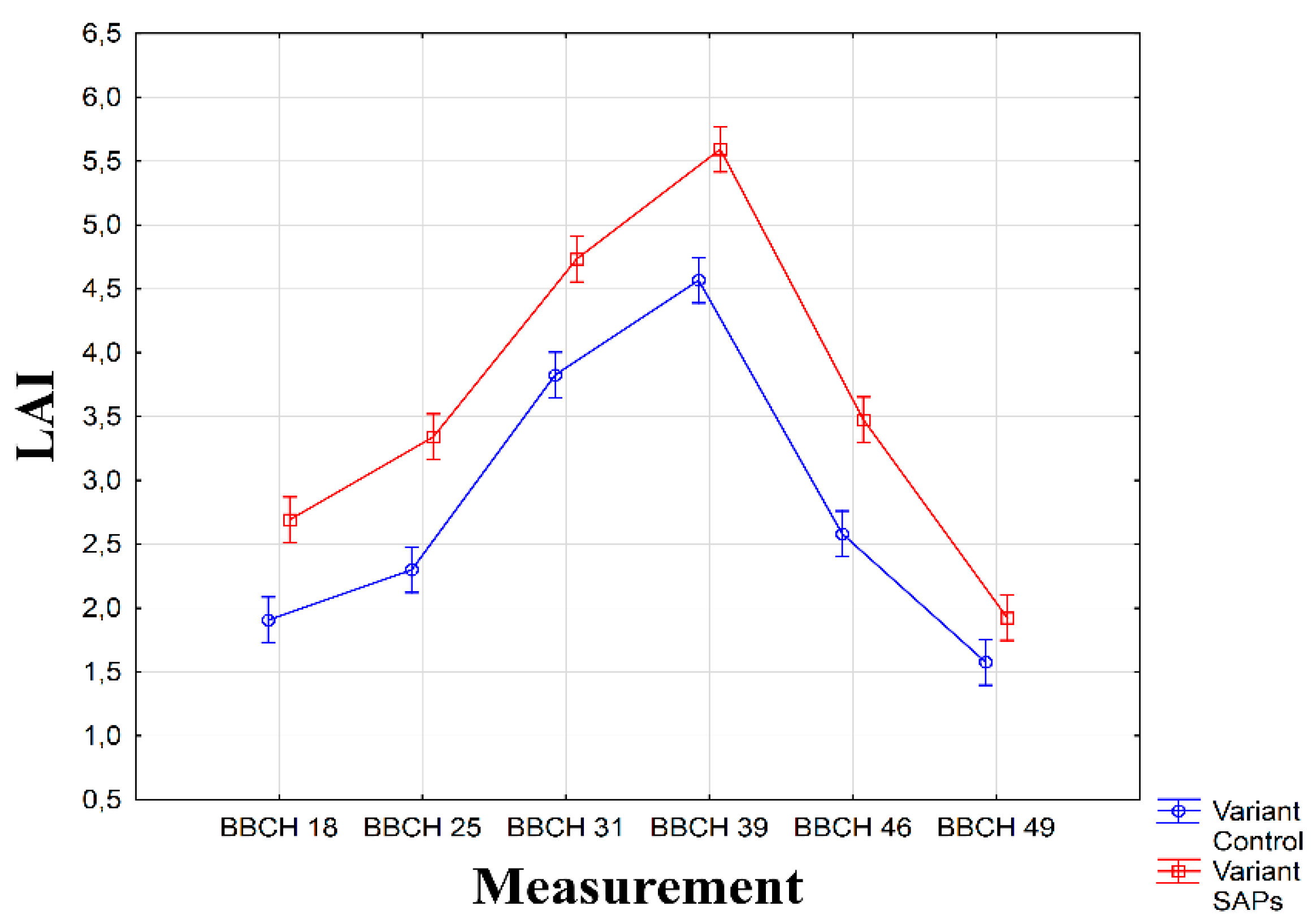

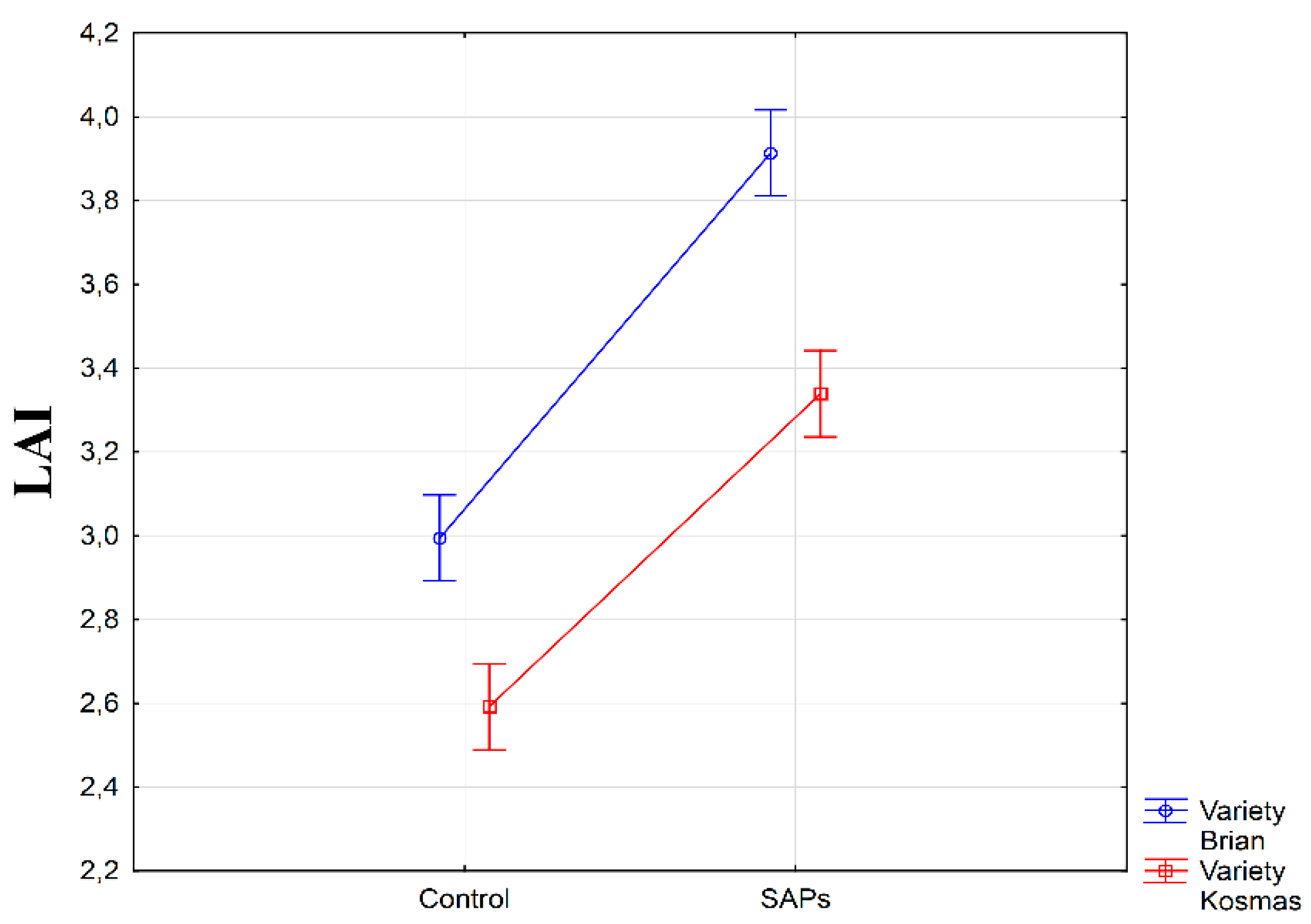

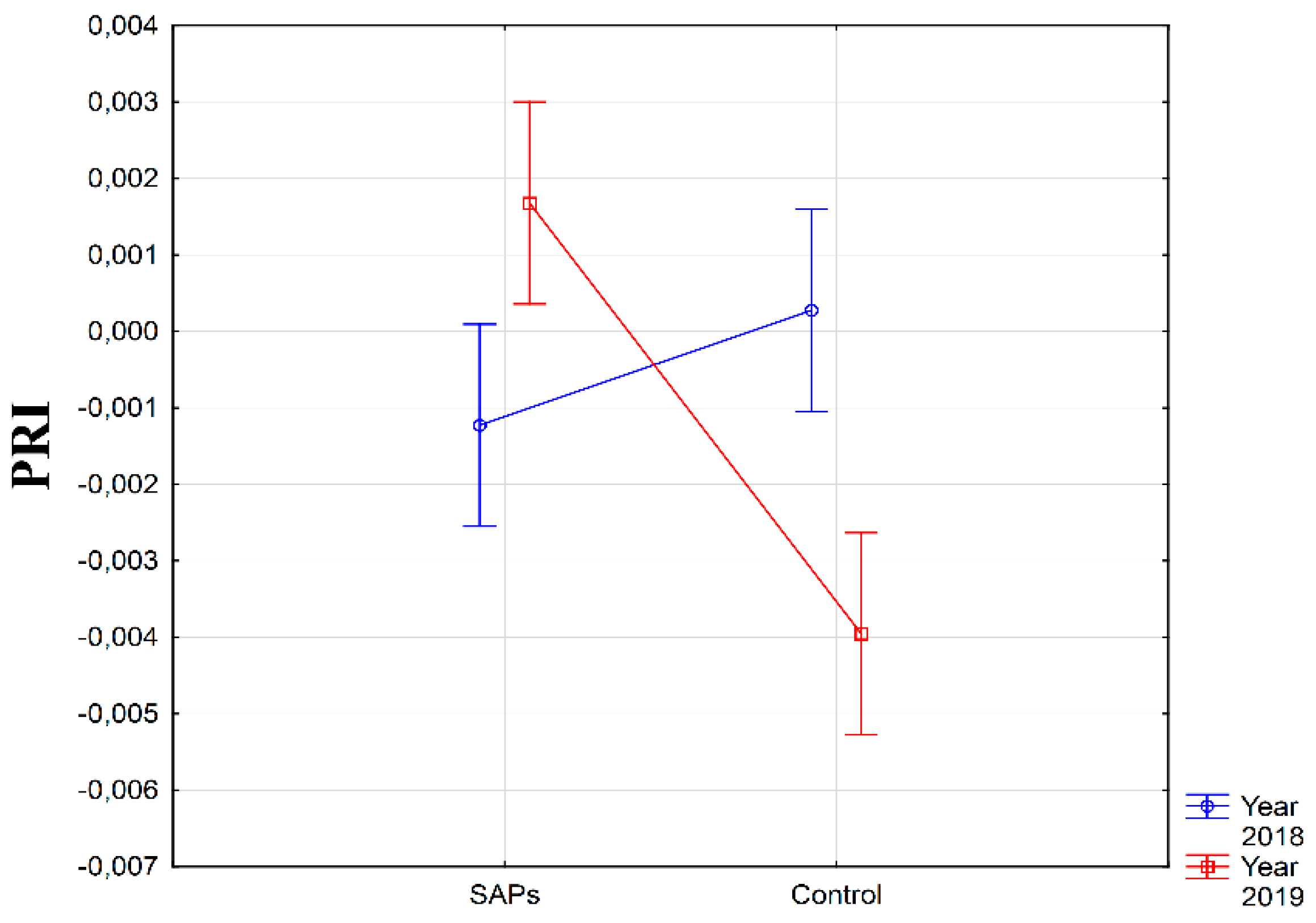


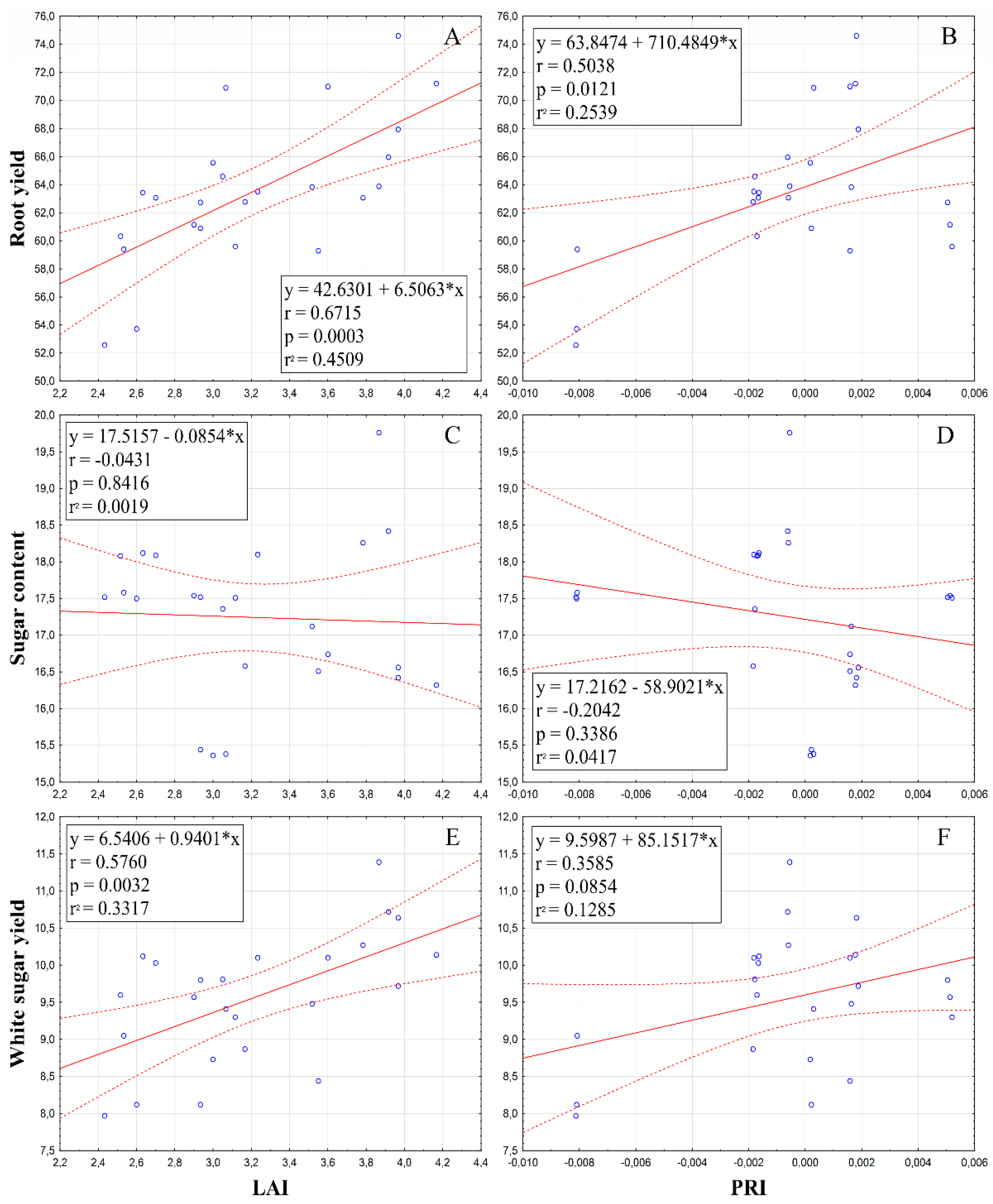

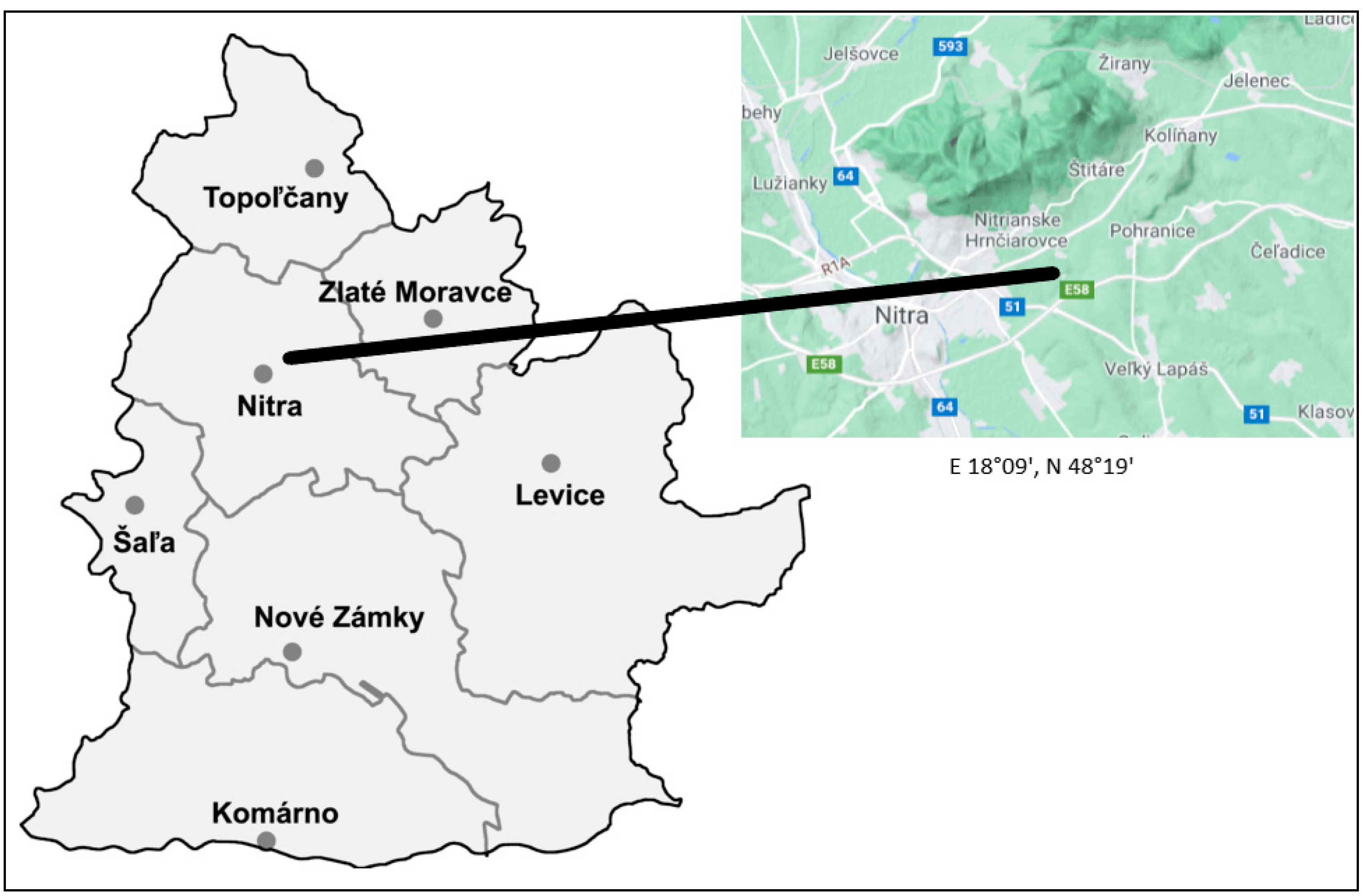
| Source of Variation | RY (t ha−1) | SC (%) | WSY (t ha−1) | LAI (m2 m−2) | PRI |
|---|---|---|---|---|---|
| p-Values | |||||
| Year | 0.3314 | 0.0000 ** | 0.0092 ** | 0.0036 ** | 0.1960 |
| Variety | 0.0138 * | 0.0550 | 0.0612 | 0.0000 ** | 0.0000 ** |
| SAPs | 0.0061 ** | 0.2798 | 0.0011 ** | 0.0000 ** | 0.0000 ** |
| Year | Nutrient Content mg kg−1 | pH | Humus (%) | ||
|---|---|---|---|---|---|
| Nan | P | K | |||
| 2017/2018 | 25.18 | 93 | 385 | 6.28 | 1.72 |
| 2018/2019 | 10.00 | 63 | 315 | 6.69 | 1.60 |
Publisher’s Note: MDPI stays neutral with regard to jurisdictional claims in published maps and institutional affiliations. |
© 2021 by the authors. Licensee MDPI, Basel, Switzerland. This article is an open access article distributed under the terms and conditions of the Creative Commons Attribution (CC BY) license (https://creativecommons.org/licenses/by/4.0/).
Share and Cite
Pačuta, V.; Rašovský, M.; Michalska-Klimczak, B.; Wyszyňski, Z. Impact of Superabsorbent Polymers and Variety on Yield, Quality and Physiological Parameters of the Sugar Beet (Beta vulgaris prov. Altissima Doell). Plants 2021, 10, 757. https://doi.org/10.3390/plants10040757
Pačuta V, Rašovský M, Michalska-Klimczak B, Wyszyňski Z. Impact of Superabsorbent Polymers and Variety on Yield, Quality and Physiological Parameters of the Sugar Beet (Beta vulgaris prov. Altissima Doell). Plants. 2021; 10(4):757. https://doi.org/10.3390/plants10040757
Chicago/Turabian StylePačuta, Vladimír, Marek Rašovský, Beata Michalska-Klimczak, and Zdzislaw Wyszyňski. 2021. "Impact of Superabsorbent Polymers and Variety on Yield, Quality and Physiological Parameters of the Sugar Beet (Beta vulgaris prov. Altissima Doell)" Plants 10, no. 4: 757. https://doi.org/10.3390/plants10040757
APA StylePačuta, V., Rašovský, M., Michalska-Klimczak, B., & Wyszyňski, Z. (2021). Impact of Superabsorbent Polymers and Variety on Yield, Quality and Physiological Parameters of the Sugar Beet (Beta vulgaris prov. Altissima Doell). Plants, 10(4), 757. https://doi.org/10.3390/plants10040757





